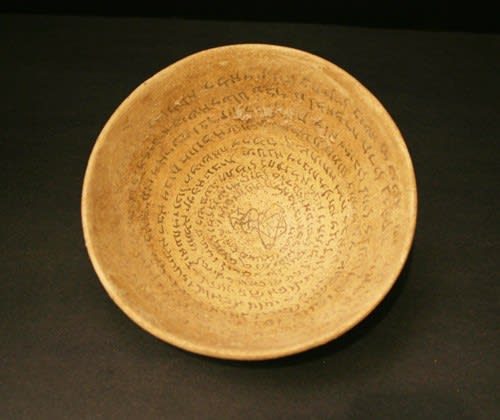Terracotta Incantation Bowl, 500 CE - 800 CE
Terracotta
2.5 x 6.25
SP.439
Further images
Inscribed with magic texts, these bowls were used to ward off evil spirits and protect family and property. Unearthed at relatively high levels of excavation, they were neglected by the...
Inscribed with magic texts, these bowls were used to ward off evil spirits and protect family and property. Unearthed at relatively high levels of excavation, they were neglected by the nineteenth century pioneers of Mesopotamian archaeology who were more interested in discovering palace foundations and large-scale sculpture. In more recent years however their importance has been recognised and they have been studied in-depth.
The incantations were written in a variety of Aramaic dialects including Jewish Aramaic, Mandaic and Syriac. There are also examples written in Pseudo-script, presumably by less literate scribes. Although the texts are not dated they are generally assigned to the late Sassanian/ early Islamic period (6th-8th century A.D.). Their main function was to trap evil spirits and they were often placed upside down at the corners of rooms, or built into foundations or cemeteries. The texts sometimes instruct them to be placed ‘at the four corners (of the room)’ for extra protection. The names of the clients for whom the bowls were made can be divided into two main categories- Semitic and Persian. However this is not always a reliable guide to their ethnicity. Jewish influence on the Mandaic inscriptions was minimal but is pronounced in the Aramaic incantations. Many of the scribes may have been Jewish or trained by Jews, and the Hebrew Bible is frequently quoted.
The adversaries are rarely named but they are sometimes depicted in fantastic line drawings, applied to the surface of the clay with a reed pen and black ink. These demons are often depicted fettered in chains with splayed legs and long dishevelled hair. Men and women are both portrayed although the sex is frequently ambiguous. The bowls themselves are all wheel-made and their form derives from the repertoire of Sassanian household vessels. They were not however recycled but made specifically to receive incantations as there are rarely signs of daily wear and tear. The shape was important as they had to have wide-open orifices to receive the maximum amount of text and a relatively smooth surface for its application. The patterns created by the writing are remarkable; the most common arrangement was in concentric spirals, radiating outwards from the centre, but there were many other varieties. On very rare instances the text continued onto the exterior of the bowl.
These bowls are fascinating for the insight they provide into popular magic and belief. In addition to the heartland of ancient Mesopotamia they have been discovered in Jordan, Syria, Lebanon and even Egypt and Uzbekistan- attesting to their widespread popularity. Ink drawings/inscriptions rarely survive from such and early date and thus these bowls give us a rare glimpse of the work of the ancient scribes.
References:
J. B. Segal, ‘Catalogue of the Aramaic and Mandaic Incantation Bowls in the British Museum,’ (London, 2000) (AM)
The incantations were written in a variety of Aramaic dialects including Jewish Aramaic, Mandaic and Syriac. There are also examples written in Pseudo-script, presumably by less literate scribes. Although the texts are not dated they are generally assigned to the late Sassanian/ early Islamic period (6th-8th century A.D.). Their main function was to trap evil spirits and they were often placed upside down at the corners of rooms, or built into foundations or cemeteries. The texts sometimes instruct them to be placed ‘at the four corners (of the room)’ for extra protection. The names of the clients for whom the bowls were made can be divided into two main categories- Semitic and Persian. However this is not always a reliable guide to their ethnicity. Jewish influence on the Mandaic inscriptions was minimal but is pronounced in the Aramaic incantations. Many of the scribes may have been Jewish or trained by Jews, and the Hebrew Bible is frequently quoted.
The adversaries are rarely named but they are sometimes depicted in fantastic line drawings, applied to the surface of the clay with a reed pen and black ink. These demons are often depicted fettered in chains with splayed legs and long dishevelled hair. Men and women are both portrayed although the sex is frequently ambiguous. The bowls themselves are all wheel-made and their form derives from the repertoire of Sassanian household vessels. They were not however recycled but made specifically to receive incantations as there are rarely signs of daily wear and tear. The shape was important as they had to have wide-open orifices to receive the maximum amount of text and a relatively smooth surface for its application. The patterns created by the writing are remarkable; the most common arrangement was in concentric spirals, radiating outwards from the centre, but there were many other varieties. On very rare instances the text continued onto the exterior of the bowl.
These bowls are fascinating for the insight they provide into popular magic and belief. In addition to the heartland of ancient Mesopotamia they have been discovered in Jordan, Syria, Lebanon and even Egypt and Uzbekistan- attesting to their widespread popularity. Ink drawings/inscriptions rarely survive from such and early date and thus these bowls give us a rare glimpse of the work of the ancient scribes.
References:
J. B. Segal, ‘Catalogue of the Aramaic and Mandaic Incantation Bowls in the British Museum,’ (London, 2000) (AM)





